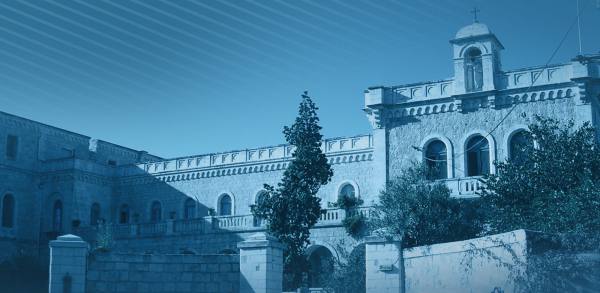On the 20th of March 2024, the students of the Salesian Pontifical University (STS), Jerusalem Campus had an archaeological excursion, visiting TEL ARAD – SHIVTA – and MITZPE RAMON (panoramic view). Since it was a long trip, they left at 7:15 hrs., from the Salesian Pontifical University (STS), Jerusalem campus, in the Ratisbonne community. Fr Yunus DEMIRCI, OfmCap. guided the archaeological excursion.

Students of STS with the STS Principal Fr. Andrzej Toczyski, SDB.
TEL ARAD
We began the archaeological excursion with a visit to Tel Arad. Tel Arad (Hebrew: תל ערד), Arabic Tell ‘Arad (تل عراد), is an archaeological tel, or mound, located west of the Dead Sea, approximately 10 kilometres (6 miles) west of the modern Israeli city of Arad into an area surrounded by mountain ridges known as the Arad Plain. The Tel overlooks an important crossroads from the Bronze Age to the present day. During the Iron Age, Arad defended the main road from Jerusalem, Hebron, and the Arad Valley to the ruins of Horvat Uza and the Dead Sea.
In total, 18 seasons of excavations took place, 14 of which focused on the Early Bronze Age city and were led by Ruth Amiran. The first expedition took place there between 1962 and 1966 and the second between 1971 and 1980. Yochanan Aharoni mostly led the excavations of the Mound of the Citadel. Today the site is declared a national park managed by the Israel Nature and Parks Authority.[1] After finishing the visit to Tel Arad, they visited Shivta.
SHIVTA
Shivta (Hebrew: שבטה), originally Sobata (Greek: Σόβατα) or Subeita (Arabic: شبطا), is an ancient city in the Negev Desert in Israel located 43 kilometres southwest of Beersheba. Shivta was declared a UNESCO World Heritage Site in June 2005, as part of the Incense Route and Desert Cities of the Negev, along with Haluza/Elusa, Avdat and Mamshit/Mampsis. The name Shivta is a modern Hebraization, given by the Negev Naming Committee in the early 1950s. The Greek name Sobata was mentioned in the Nessana papyri.
Ruins of Shivta: Long considered a classic Nabataean city on the ancient spice route, archaeologists are now considering the possibility that Shivta was a Byzantine agricultural settlement and a stopover for pilgrims en route to St. Catherine’s Monastery in the Sinai Peninsula. A few ruins from the Roman period have been discovered, but most archaeological finds date from the Byzantine period. Shivta’s water supply was based on surface runoff collected in large reservoirs.
Roman Period: Roman ruins from the first century BCE have been discovered in the southern part of the city.
Byzantine Period: Three Byzantine churches (one main church and two smaller ones), two wine presses, residential areas and administrative buildings were excavated.
Churches: Traces of a wall painting of the transfiguration of Christ were discovered in the apse of the south church, as well as the remains of a colourful 6th-century mosaic and a beardless depiction of Jesus in the north church.
Agriculture (wine): The Shivta wine presses provide an insight into the scale of wine production at the time. According to archaeologists’ calculations, the Nabataean/Byzantine village of Shivta produced approximately two million litres of wine.
After finishing the visit to Shivta, they went to Mitzpe Ramon.
MITZPE RAMON (panoramic view)
Mitzpe Ramon (Hebrew: מִצְפֵּה רָמוֹן, Ramon Lookout; Arabic: متسبي رمون) is a local council in the Negev Desert in southern Israel. It is located on the northern ridge at an altitude of 860 meters (2,800 ft) overlooking the world’s largest erosion cirque, known as Makhtesh Ramon. In 2022, it had 5,263 inhabitants.
Mitzpe Ramon was founded in 1951 as a camp for workers building Highway 40. The town’s first permanent residents, several young families from Kibbutz Re’im and other areas of Israel, began moving there. After five years, the town was home to 370 residents including 160 children, most of them Israeli veterans. There were also 180 housing units to absorb new immigrants. They were joined by immigrants from North Africa, Romania and India in the 1960s, and it became the southernmost of the Negev’s developing cities.
We ended the day with a visit to the Dead Sea, where we had a bath, and then went back to Jerusalem.
Kelvin Mutalala, M.Afr.

